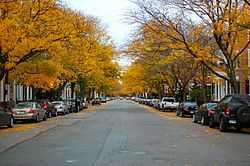Chestnut Street District
|
Chestnut Street District | |
 | |
|
Looking east on Chestnut Street in the fall | |
 | |
| Location | Salem, Massachusetts |
|---|---|
| Coordinates | 42°31′13″N 70°54′8″W / 42.52028°N 70.90222°WCoordinates: 42°31′13″N 70°54′8″W / 42.52028°N 70.90222°W |
| Built | 1651 |
| Architect | Multiple |
| Architectural style | Mid 19th Century Revival, Colonial, Federal |
| Governing body | Local |
| NRHP Reference # |
73000312 [1] |
| Added to NRHP | August 28, 1973 |
The Chestnut Street District is a historic district bounded roughly by Broad, Flint, Federal, and Summer Streets in Salem, Massachusetts. , also known as the McIntyre Historic District that was created in 1981 and containing 407 buildings and is the city's largest district. This historic district is named after Samuel McIntire. Samuel McIntire had a house and workshop that was located 31 Summer Street, at the intersection of Chestnut Street where many grand mansions designed by McIntire and others display the profits of the Old China Trade.
The first of these great brick Federal houses to be constructed was the Thomas Saunders House of 1805 at number 39 Chestnut, later remodeled by Arthur Little (1893). Saunders also built the famous McIntire-designed double house next door at numbers 41-43, in 1810, as a wedding present for his daughters Mary Elizabeth and Caroline, who married brothers Leverett and Nathaniel Saltonstall. Leverett Saltonstall I was Salem's first elected mayor. Some other examples of notable Salem architecture within or just outside the district are listed below. A short 10-minute walk from the Chestnut Street District, the Salem Maritime National Historic Site consists of 12 historic structures and about 9 acres (36,000 m2) of land along the waterfront in Salem, Massachusetts. Other historic districts that are nearby are the Federal Street District, Salem Willows Historic District, Downtown Salem District, Charter Street Historic District, Crombie Street District, Derby Waterfront District, Bridge Street Neck Historic District, Essex Institute Historic District, Old Town Hall Historic District and the Salem Common Historic District

Hamilton Hall
Hamilton Hall is a National Historic Landmark at 9 Chestnut Street in Salem, Massachusetts. Hamilton Hall was built in 1805 by Samuel McIntire and added to the National Register of Historic Places in 1970.[1][2]
Ropes Mansion
The Ropes Mansion (late 1720s), also called Ropes Memorial, is a Georgian Colonial mansion located at 318 Essex Street. It is now operated by the Peabody Essex Museum and open to the public.
Stephen Phillips House
Stephen Phillips House is located at 34 Chestnut Street. A classic car show is held every year at the The Stephen Phillips House. The Phillips House is now owned and operated as a historic house museum by Historic New England and is open for public tours.
Pickering House
Pickering House (Salem, Massachusetts) (circa 1651) is a Colonial house, owned and occupied by ten successive generations of the Pickering family including Colonel Timothy Pickering. This house is believed to be the oldest house in the United States continuously occupied by one family. It is located at 18 Broad Street, Salem, Massachusetts and is open to the public under the auspices of the nonprofit Pickering Foundation.
The Witch House, Jonathan Corwin House
The Witch House (also called the Jonathan Corwin House), was the home of Judge Jonathan Corwin and is the only structure still standing in Salem, Massachusetts with direct ties to the Salem Witch Trials of 1692.
The Salem Athenaeum
The Salem Athenaeum was founded in 1810 and is one of the oldest private library organizations in the United States. The Athenaeum is located at 337 Essex Street in Chestnut Street District. In 1905, the Athenæum sold the building at 132 Essex Street to the Essex Institute (now the Peabody Essex Museum), and with the proceeds constructed the building it currently occupies, at 337 Essex Street. Dedicated in 1907
Francis Cox House
The Francis Cox House was built in 1846 and is situated at the corner of Chestnut and Summer street in the Chestnut Street District and is in the National Register of Historic Places.
John Bertram Mansion

This High Style Italianate brick and brownstone mansion was built at 370 Essex Street in 1855 for Captain John Bertram When Captain John Bertram died in March of 1882, his widow donated their home ( The John Bertram Mansion ) and this became the Salem Public Library. The Salem Public Library opened its doors on July 8, 1889 and is in the National Register of Historic Places.
See also
- List of the oldest buildings in Massachusetts
- List of the oldest buildings in the United States
- List of historic houses in Massachusetts
- National Register of Historic Places listings in Salem, Massachusetts
- National Register of Historic Places listings in Essex County, Massachusetts
References
- ↑ 1.0 1.1 "National Register Information System". National Register of Historic Places. National Park Service. 2008-04-15.
- ↑ Hamilton Hall NHL listing info
| ||||||||||||||||||||||||||||||||||||||||
